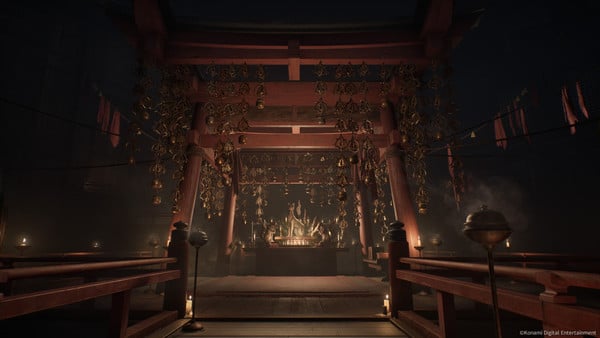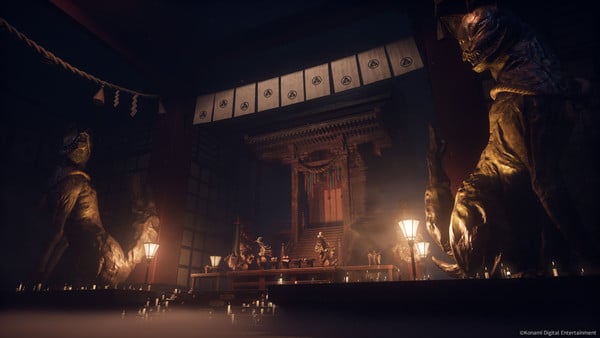From Lovecraft to the Fear of the Unknown: Silent Hill f and Fatal Frame: Crimson Butterfly
by Asha Bardon,Japan-set games are experiencing a much-needed Renaissance, with Silent Hill f's releaase on PC and consoles this month, as well as the announcement of a Fatal Frame: Crimson Butterfly Remake coming in 2026, along with a release for Nioh 3 in February and Ghost of Yōtei getting supernatural-themed co-op later in the year. So, why is this niche so beloved, and what else can we expect to see as we return to games that focus on Japanese folklore, culture, and horror?

In the early 2000s, two significant developments occurred in Japanese media. The first was the J-horror boom, which saw the export of classic horror films such as Ringu, Juon: The Grudge, and Kairo. These films introduced the yūrei to Western audiences, predominantly female ghosts wearing white shrouds. Yūrei are a subset of onryō, vengeful spirits whose ranks include Emperor Sutoku, Taira no Masakado (now regarded as the patron deity of Tokyo), and Sugawara no Michizane (now known as Tenjin, the kami that students pray to ahead of exam season in Japan).
Technically, yūrei are vengeful spirits of either gender; Japan even has the Three Great Yūrei, comprising Okiku, Oiwa, and the Otsuyu, three tragic female figures from Japanese horror stories, or kaidan. Of the three, Oiwa is probably the most (in)famous, and it's her tragic story of betrayal in the Yotsuya Kaidan that has inspired Sadako Yamamura, the badly treated and terrifying vengeful spirit from Ringu.
The second boom was in the creation of the survival horror genre. This was a new type of game, nestled within the larger horror game genre, in which players took the role of a (usually) female or everyman male protagonist who was thrown into a living nightmare in which they had to survive against supernatural entities or monsters.
These games: Silent Hill, Resident Evil, Clocktower, Haunting Ground, and Rule of Rose, were all variations on a theme. Some leaned into zombies, others monsters, some supernatural elements, but most of them continued to use Western elements, despite being created by Japanese developers and directors.
After the success of Silent Hill, several members of Team Silent stepped away to begin work on a new type of game: Fatal Frame. This game used Japanese elements to be scary, including setting it in a haunted Japanese mansion and featuring a physically weak female protagonist, Miku Hinasaki. She must use her wits and a mystical camera to solve puzzles and vanquish ghosts.

The game did pretty well, including release in Europe and the U.S. It soon got a sequel and sparked a PS2 boom in Japan-set survival horror. Crimson Butterfly gave us twin protagonists Mio and Mayu Amakura, and an entire village, Minakami Village, to explore. The game remains one of the highlights of the genre, forcing gamers to focus their fear to get that perfect Fatal Frame. It is this game which eventually got a 'Wiimake' in 2012, which included different perspectives, new graphics, and several new endings, as well as a new image song from series regular Tsuki Amano
This game also marked a short renaissance in which many survival horror games found a home on the Wii. from the jump-scare focused adaptation of Juon to Japan-only release of the fourth title in the Fatal Frame series, Mask of the Lunar Eclipse, released for the Wii in 2008, and a fifth, Maiden of Black Water, in 2015. Both of these titles would only get a multi-format worldwide re-release in 2021 and 2023. It was the success of these releases that paved the way for KOEI's remake of Crimson Butterfly.
This is when FromSoftware, probably better known for Dark Souls, Elden Ring, and Bloodborne, dipped their toes into the genre with Kuon. This game was set during the Heian period in Kyoto and focused on onmyoji, bureaucrats with magical abilities who served as state magi. The game had players take on three different female roles, including a gender-swapped version of the famous onmyoji Abe no Seimei, to explore and exorcise a haunted mansion using Buddhist practices and rituals.
Around the same time, another team at Japan Studio was working on SIREN. This game mixed zombies with a supernatural backdrop of a rural town that practiced a strange monotheistic religion. Its big gimmick was not a camera but the ability to Sightjack —seeing through others' eyes— and to be their friends or enemies.
Hanyuda, the town where the game was set, blends Japanese design and a rural aesthetic with aliens. Characters include a blind woman, a teenager, a folklorist and his assistant, a teacher, and a small girl. Each gets their own route, with the need to replay to unlock certain endings and find 100 Archives, the game's collection of lore.
Despite a questionable English dub and passable localization, Siren 2 would follow, as well as a 'reimagining' for the PS3 called Blood Curse/New Translation, which introduced several American characters lost in rural Japan. A movie, loosely based on the games, was also released to mixed reviews, and the series's realms are very popular in Japan with various manga, figurines, and other merchandise.
Japan-set survival horror is unique in the horror genre because many players aren't Japanese. This means the horror not only hits different, but the tropes are also very different, something the genre has used to its advantage. They also take aspects of culture and religion, found in the real world, and twist them into something horrific. For example, it's similar to how English-speaking cultures will talk about angels and demons, and then create a religious horror movie like The Exorcist or The Conjuring.
Folklorist and manga translator Zack Davisson, who has worked with Gou Tanabe on his adaptation of H.P. Lovecraft's stories in manga form, as well as writing the literal book on yūrei, explains: “Japan has refined its culture of horror and monsters for centuries. Much of it has its roots in the Edo period (1603-1868), Japan's version of the Renaissance. But while Italy was making cathedrals and great works of art, Japan was making monsters.
“The perfect storm of the invention of the grand guignol that is Kabuki theater, the creation of mass production of art via woodblock printing, and the pallor game HyakumonogatariKaidankai.” He explains. “A storytelling game, hyakumonogatarikaidankai was played by placing a hundred candles in a room. Each person told a spooky tale, then extinguished a candle. As the room got darker and darker, the stories got scarier and scarier.
“The story was a test of courage, with each player testing their nerves until finally someone would stop the game before the final candle was extinguished. Should the final candle go out, it was said a yokai called blue andon would appear and would kill everyone in the room. So there was no incentive to play the game to completion. The best kaidankai stories would be turned into kabuki plays, which would then be turned into art prints, and the cycle would continue. Most of Japan's most famous yurei and yokai appeared in this way.
Both Shinto and Buddhism pair nicely with the idea of cursed villages, vengeful ghosts, monsters found in rural folklore, and horrendous calamities, which can only be mitigated by the suffering of a single, usually female, soul to save the community as a whole.
Most horror games are also set in rural towns from the 1960s through to the 1990s. Hanyuda, Minakami, Ebisugaoka, Yamajima, Rogetsushima —these are all places very far from Japan's modern cities and also divorced from modern-day technological advancement. These are places where personal narratives and the histories remembered by inhabitants are stronger than science and the light of the day.
Davisson continues: “As to why Westerners enjoy it, well, I think largely it is because the unfamiliarity of it all adds an exotic flavor to the horror. As horror writer H.P. Lovecraft said in his essay 'Supernatural Horror in Literature', “The oldest and strongest emotion of mankind is fear, and the oldest and strongest kind of fear is fear of the unknown.”
“The horror from another culture adds an extra layer of the unknown. It is difficult to truly frighten anyone with the familiar.” He says. ”Vampires, werewolves, ghouls, and the like have become pop culture schlock by now. To find something more frightening, an easy way is to look at other cultures. And Japan's monsters are just familiar enough, while just exotic enough to supply that delicious sensation of fear. Plus, Japan is just amazing at character design. That is a national skill they bring into play when designing yokai and yurei.”

Silent Hill f encapsulates this as it becomes the first entry in an otherwise Western-focused horror franchise to be set in Japan. Following a teenage girl named Hinako Shimizu, the game sees the player exploring a fog-wrapped town with monsters around every corner, shrines guarded by stone foxes, and even an entire, albeit twisted, otherworld set in a darker version of a Shinto shrine.
Here, the lack of knowledge, the confusion, and the constant attacks of doll-like monsters push the player into a constant state of fear and panic, which turns the fear in the pit of your stomach into something more visceral. The story leans hard into both survival and psychological horror, which only deepens with each playthrough (the game requires at least two passes, at minimum, even to understand the full story).
Japanese folklore, in particular, has power because it endures longer than accepted history. If enough people say there's a kappa in the river, then it must be so. Books hold memory as well as power, making them a much more effective go-to when researching ancient lore to solve puzzles than simply grabbing a smartphone and asking Google. Searching for lore, for answers to questions you can't yet formulate, piecemeal, is as much a part of survival horror as the monsters and bosses that must be faced and overcome.
As 2026 approaches and a new golden age of Japan-set supernatural horror beckons, we can only see it through modern consoles and new takes on old, unsettling stories. This new boom will go beyond what was seen in the mid-2000s, especially with modern gaming engines, graphics that push the boundaries of realism, and the desire to create new and unsettling stories. It's sure to be a good time for anyone fascinated with horror games, Japanese folklore, and ghost stories.
discuss this in the forum (1 post) |